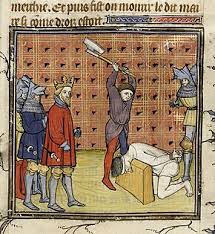Stamp: The dame's game (San Marino 1996)
The dame's game (San Marino 1996)
06 May (San Marino ) within release Medieval Days goes into circulation Stamp The dame's game face value 750 Sammarinese lira
| Stamp The dame's game in catalogues | |
|---|---|
| Michel: | Mi:SM 1657 |
| Stamp Number: | Sn:SM 1361 |
Stamp is vertical format.
Also in the issue Medieval Days:
- Stamp - The loom face value 750;
- Stamp - The potter face value 750;
- Stamp - The tailor face value 750;
- Stamp - The dame's game face value 750;
- Stamp - The trumpeters face value 750;
- Stamp - The bannermen face value 750;
- Stamp - The crossbow men face value 750;
- Stamp - The performers face value 750;
- Booklet Pane - Medieval days face value 8*750;
Stamp The dame's game it reflects the thematic directions:
Sports, are all usually forms of competitive physical activity or games which, through casual or organised participation, aim to use, maintain or improve physical ability and skills while providing enjoyment to participants, and in some cases, entertainment for spectators. Usually the contest or game is between two sides, each attempting to exceed the other. Some sports allow a tie game; others provide tie-breaking methods, to ensure one winner and one loser. A number of such two-sided contests may be arranged in a tournament producing a champion. Many sports leagues make an annual champion by arranging games in a regular sports season, followed in some cases by playoffs. Hundreds of sports exist, from those between single contestants, through to those with hundreds of simultaneous participants, either in teams or competing as individuals. In certain sports such as racing, many contestants may compete, each against each other, with one winner.
In the history of Europe, the Middle Ages or medieval period (also spelt mediaeval or mediæval) lasted approximately from 500 AD to 1500, although some prefer other start and end dates. The Middle Ages is the second of the three traditional divisions of Western history: antiquity, medieval, and modern. Major developments include the predominance of agriculture in the economy, the exploitation of the peasantry, slow interregional communication, the importance of personal relationships in power structures, and the weakness of state administration. The period is sometimes subdivided into the Early, High, and Late Middle Ages, and the early medieval period is alternatively referred to as the Dark Ages.
Chess is usually played by two players (called chess players) against each other. It is also possible for one group of chess players to play against another or against one player; such games are often called consultation games. In addition, there is the practice of simultaneous play sessions, when several opponents play against one strong player, each on a separate board.
The rules of the game were basically developed by the 15th century; In modern official tournaments, the rules of the International Chess Federation[6] are applied, which regulate not only the movement of pieces, but also the rights of the judge, the rules of behavior of players and time control. A game played remotely - for example, by correspondence, by telephone or via the Internet - has special rules. There are many variants of chess that differ from classical ones: with non-standard rules, pieces, board sizes, etc. The corresponding section of chess composition is fairy chess. Some aspects of the game of chess are studied in mathematics (for example, the classic “Knight's Move Problem” and “Eight Queens Problem”), including through computer simulation. Chess is usually played by two players (called chess players) against each other. It is also possible for one group of chess players to play against another or against one player; such games are often called consultation games. In addition, there is the practice of simultaneous play sessions, when several opponents play against one strong player, each on a separate board.
The rules of the game were basically developed by the 15th century; In modern official tournaments, the rules of the International Chess Federation[6] are applied, which regulate not only the movement of pieces, but also the rights of the judge, the rules of behavior of players and time control. A game played remotely - for example, by correspondence, by telephone or via the Internet - has special rules. There are many variants of chess that differ from classical ones: with non-standard rules, pieces, board sizes, etc. The corresponding section of chess composition is fairy chess. Some aspects of the game of chess are studied in mathematics (for example, the classic “Knight's Move Problem” and “Eight Queens Problem”), including through computer simulation.
A dam is a barrier that stops or restricts the flow of surface water or underground streams. Reservoirs created by dams not only suppress floods but also provide water for activities such as irrigation, human consumption, industrial use, aquaculture, and navigability. Hydropower is often used in conjunction with dams to generate electricity. A dam can also be used to collect or store water which can be evenly distributed between locations. Dams generally serve the primary purpose of retaining water, while other structures such as floodgates or levees (also known as dikes) are used to manage or prevent water flow into specific land regions.




